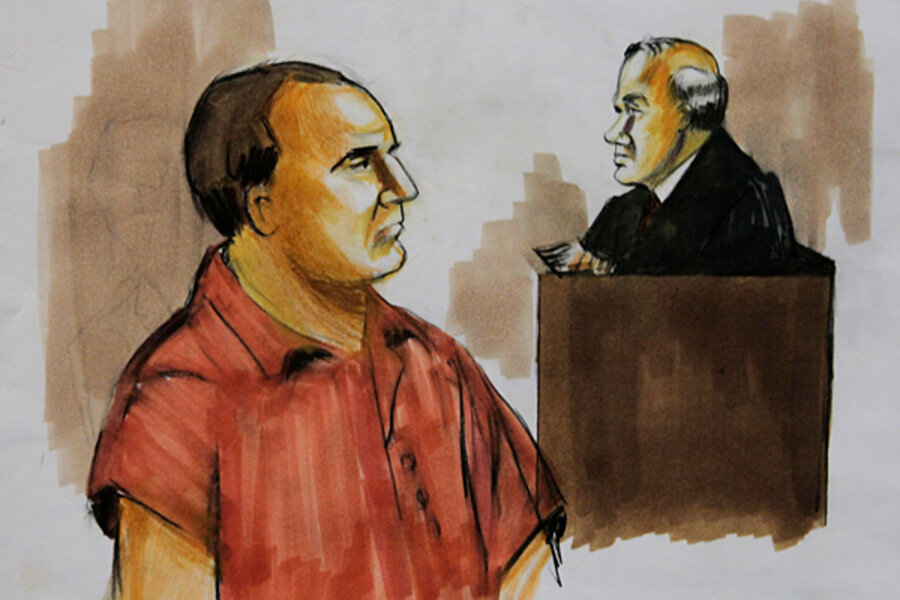David Headley pleads guilty in 2008 Mumbai terrorist attack
Loading...
Facing a possible death sentence, a Chicago man agreed to plead guilty on Thursday to performing advance surveillance that helped lay the groundwork for the deadly 2008 terrorist attack on civilians in Mumbai, India.
David Coleman Headley, a US citizen, could have been sentenced to death by lethal injection for his alleged involvement in the India attacks that left more than 164 dead, including six Americans. But with his guilty plea, prosecutors have agreed not to seek the death penalty or to extradite him to India, Pakistan, or Denmark.
The agreement, announced in federal court in Chicago, is contingent on Mr. Headley’s full cooperation with US intelligence officials and prosecutors. Under sentencing guidelines he could receive a prison term of up to life in prison. But his prison time could be reduced based on the value of his cooperation.
Headley’s plea agreement says he’s been cooperating with US officials since his arrest in October 2009, and that he has already provided “substantial assistance.”
“Not only has the criminal justice system achieved a guilty plea in this case, but David Headley is now providing us valuable intelligence about terrorist activities,” Attorney General Eric Holder said. “As this case demonstrates, we must continue to use every tool available to defeat terrorism both at home and abroad.”
Headley was among four men named in a 12-count indictment returned by a Chicago grand jury in January for involvement in two plots: the 2008 Mumbai attack, and a separate plot to murder an editor and an illustrator at a Danish newspaper.
The Danish paper, Morgenavisen Jyllands-Posten, printed a cartoon depiction of the Prophet Mohammed in September 2005 that many Muslims found highly offensive. That plot was never carried out.
Headley’s plea agreement reveals new details about the alleged plot. It says a Pakistan-based militant leader with ties to Al-Qaeda suggested that Europe-based operatives could provide manpower for a suicide attack on the newspaper offices.
The leader said once inside the building the attackers should behead newspaper employees and throw their severed heads out the building “to heighten the response from Danish authorities.”
According to information in the 33-page indictment, Headley agreed to provide surveillance for the Pakistan-based militant group Lashkar-e-Tayyiba (Army of the Good). The group has long battled India over claims to the disputed territories of Jammu and Kashmir.
Lashkar has been designated a terrorist organization by both India and the United States.
The indictment says Headley attended the group’s training camps in Pakistan in 2002 and 2003. It says he conspired with Lashkar leaders from late 2005 until his arrest in 2009 to facilitate the organization’s violent objectives, including bombings and murders.
His primary role appears to have been as an advance man, scouting out the scenes of potential violent attacks. To better perform this role he changed his name in 2006 from Daood Gilani to David Coleman Headley, a name that would not suggest ties to a militant Muslim group.
Using his new name and funds supplied by Lashkar, Headley opened a travel office in Mumbai. US officials say it was a cover to allow him to conduct pre-attack surveillance. From 2006 to 2008, Headley took photographs and made video recordings of hotels, meeting places, and other public locations in Mumbai. He was even instructed to use a handheld GPS unit to identify suitable places along the harbor for boat landings.
On November 26, 2008, 10 heavily-armed members of Lashkar came ashore at Mumbai harbor in rubber boats and fanned out across the city to locations that had been earlier identified and documented by Headley. Attacks were carried out at the Taj Mahal hotel, the Oberoi hotel, the Leopold Café, a Jewish community center called the Chabad House, and a major train station. The photos, videos, and GPS coordinates helped the attackers elude police and maximize the number of civilian casualties.
Among the dead were six Americans, including Rabbi Gavriel Holtzberg. His wife, Rivkah, who was also killed, was six months pregnant.
According to the indictment, four months after the Mumbai attack, in March 2009, Headley “conducted surveillance of various targets in India, including but not limited to, the National Defense College in Delhi and Chabad Houses in several cities in India.”
Headley conducted similar surveillance in advance of an alleged plot to take violent action against the Danish illustrator who drew the offensive cartoon of Mohammed, according to the indictment. In the summer of 2009, Headley traveled to Copenhagen and made 13 videos.
He met repeatedly with leaders of various militant groups in Pakistan, the indictment says, including Ilyas Kashmiri who is said by prosecutors to have been in regular contact with Al-Qaeda leaders. Headley also met with a Kashmiri associate, Abdur Rehman Hashim Syed. Both are charged in the indictment. They remain fugitives and are believed to be in the tribal regions of Pakistan.
The fourth man named in the indictment is Chicago businessman Tahawwur Hussain Rana. He is charged with providing material support to a terror organization. Mr. Rana is in US custody and is slated to stand trial.





